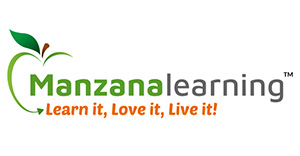Our Latin@s por siempre Program
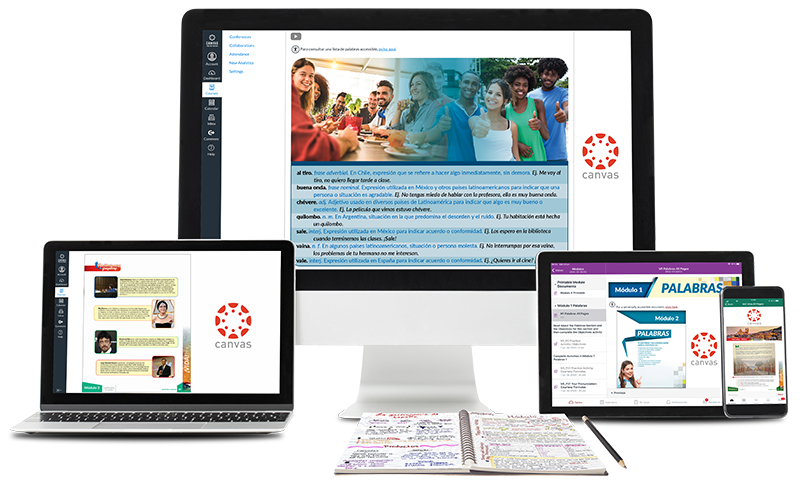
Spanish Courses for Heritage Speakers
Our Latin@s por siempre program covers 9 modules, for terms I, II and III, or other variations, depending on the course units and instructor preference.
Thanks to its modular nature, Latin@s por siempre, allows instructors to design their courses according to the specific content they want to cover in their classes. Instructors may choose among the offered modules to create a course and arrange the materials in the preferred sequence, so the course is completely adapted to the pace of the students.
The sequence of modules helps students transition from one term to the other in a seamless progression. Each Module of Latin@s por siempre contains 3 sections: “Palabras”, “Estructura” and “¡Vida!”.
About our courses
Tried, Tested and Approved
Our Courses Are Canvas-Native
Our Courses Are 100% Universally Accessible
Our Courses Allow for Total Personalization
VoiceThread Included
High Standards
Constantly Updated and Improved
Meaningful Feedback to Students
Assessment, SLOs and Rubrics
Palabras covers the same number of sections that are covered by our ¡Vida! section, 12. Each section includes a list of 25 words extracted from the ¡Vida! readings and each of them is defined and used in a sample sentence. These words are later practiced in different activities designed to reinforce students’ review/acquisition of those words and increase their lexical richness.
As an instructor, you can decide what sections of ¡Vida! your students will enjoy and align the corresponding Palabras table to ensure a solid pre-reading exposure to the target vocabulary. Though a number or words may be already known to the students, there will be others that are new. Those known words may expose the student to synonyms or word derivatives that will promote lexical sophistication.
Students are also asked to repeat and record the list of words following a modeling voice. This is a proven and tested activity that Heritage Learners enjoy and benefit from. Because words are related to content-rich readings about culture, history, geography, music, current affairs and more, there are lexical field relationships between those words. This becomes apparent as students read and repeat the words aloud.
Individual, paired, group and full class activities and discussions enable further practice and interaction. Students are asked to participate in engaging exercises, among them identification, matching, definitions and cloze readings. Activities are visually engaging and promote formative assessment.
In conclusion, the Palabras section of this class is the students’ sandbox for playing with Spanish words. Exercises prepare for extended grammar practice in Estructura, and an enriching cultural and linguistic immersion experience in ¡Vida!
The Latin@s por siempre program supports a rich, visual and engaging approach to teaching and learning Spanish grammar.
The first activity of this section sets the stage for the learning objectives in each subsection. Students are asked to complete an introductory activity using visuals that require no previous knowledge of the topic, and help students focus on what will be learned.
The Observa que area is a general introduction to the grammatical topic presented, focusing on the use of the target structure as well as its form. Grammar points are illustrated with visually rich images and accompanying sentences that demonstrate those points. An English, non-literal translation is included to help students, especially those interested in Spanish/English translation.
Ten en cuenta offers a more detailed presentation that helps introduce nuances around the main structural topic. There are many examples of translations and practical communicative applications of the topics at hand.
Recapitulando is a space for formative assessment. Each Recapitulando section starts with a series of comprehension-checks, to ensure that students were able to follow the presentation. Terminology related to the topic is reviewed, and ample practice follows.
The Latin@s por siempre ¡Vida! section is dedicated to a variety of Spanish-speaking countries, including the United States.
Naming this section ¡Vida! instead of Cultura reflects our intention to introduce students to the many aspects of life in various countries. The subsections are listed below.
Así es is a visual introduction to the country of interest. Data related to population, political geography, flag and currency are presented. A simple True/False activity promotes critical thinking and comprehension.
Todo sobre (the target country) takes a glance at the history, geography and other relevant aspects of life in the target country, from past to present.
Hecho en (the target country) highlights the arts and unique creations that represent the ingenuity of the people from the target country.
Nuestra lengua is a visual reflection on how our language works and how it can be used, following the communicative-approach premise that comprehension precedes oral production.
The Así son (people from the target country) readings introduce students to general information about historical, geographic and other challenges experienced by people of each target country.
The Para comunicarnos section focuses on functional uses of Spanish.
Nuestro espejo subsection proposes an introspective look into the lives of Latin@s. The Nuestro Espejo section of módulo 1, for example, introduces a variety of topics such as the complexities of enriching ones native language, the meanings of Latin@s’ surnames and how Latin@’s they are formed, experiencing bilingualism in the workplace, and the presence of Spanish in social media.
(Our target country) por escrito highlights the literary work of writers from the target country. Por escrito proposes writers such as Valeria Luiselli, Almudena Grandes, Javier Payeras, Marisel Hilerio or Cynthia Guardado.
Si viajas a (our target country) is a virtual invitation to explore dynamic areas of the target countries. Si viajas a represents an opportunity to familiarize students with the geography, history and the arts of Spanish-speaking countries
Aprender enseñando is a section inviting students to share the knowledge they have acquired working with their preferred section of each módulo. The activity should be submitted via Discussions in Canvas or presented in class, after students have transformed their presentation in a short but meaningful vlog.
La rica cultura (of our target country) highlights the different cultural values of the target country.
(Our target country) en nuestra música is an opportunity to study and enjoy a variety of musical selections.
(People from our target country) ejemplares is dedicated to highlight the contributions of a cross-section of exemplary people.
Our Latin@s por siempre Program
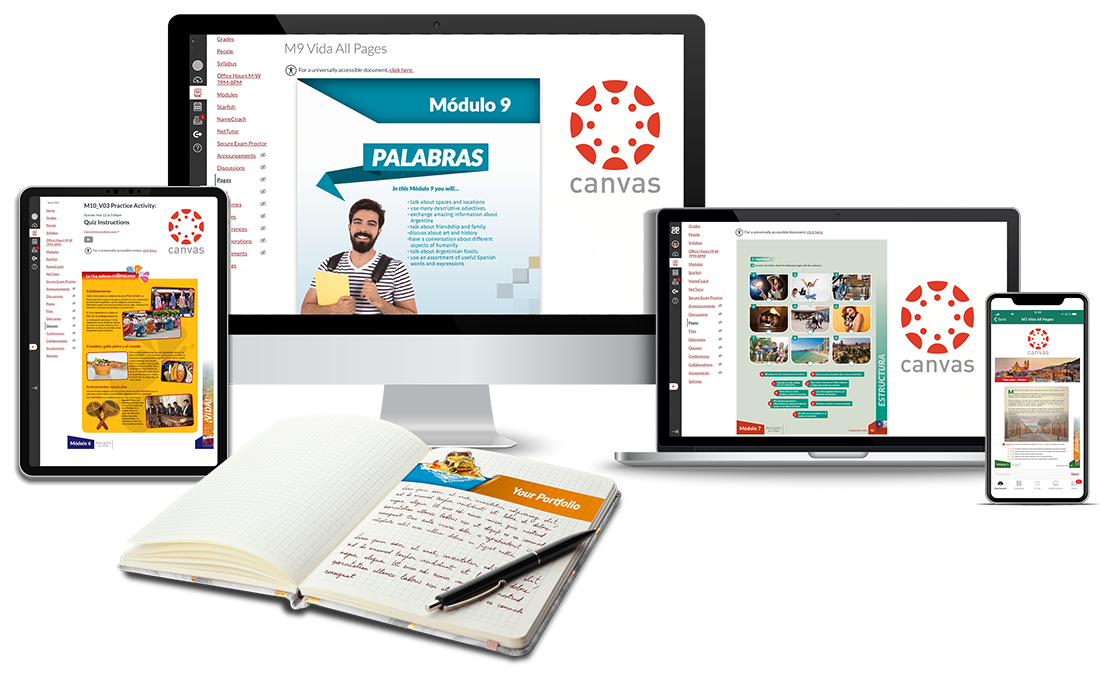
Spanish Courses for Heritage Speakers
Our Latin@s por siempre program covers 9 modules, for terms I, II and III, or other variations, depending on the course units and instructor preference.
Thanks to its modular nature, Latin@s por siempre, allows instructors to design their courses according to the specific content they want to cover in their classes. Instructors may choose among the offered modules to create a course and arrange the materials in the preferred sequence, so the course is completely adapted to the pace of the students.
The sequence of modules helps students transition from one term to the other in a seamless progression. Each Module of Latin@s por siempre contains 3 sections: “Palabras”, “Estructura” and “¡Vida!”.
About our courses
Tried, Tested and Approved
Our Courses Are Canvas-Native
Our Courses Are 100% Universally Accessible
Our Courses Allow for Total Personalization
VoiceThread Included
High Standards
Constantly Updated and Improved
Meaningful Feedback to Students
Assessment, SLOs and Rubrics
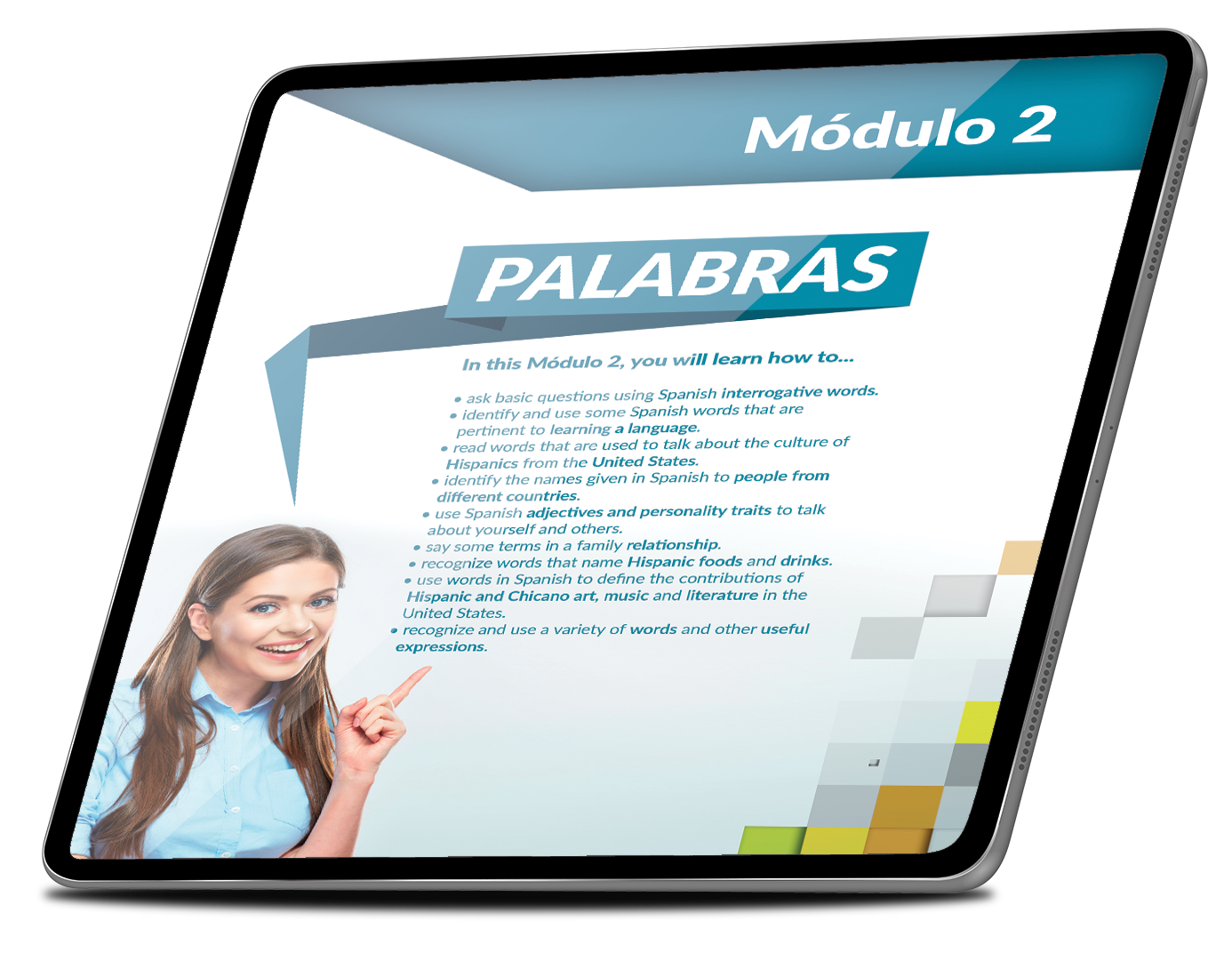
We have purposely avoided calling this section vocabulary, though it deals with words.
In every traditional textbook, the vocabulary section includes a list of words to be memorized, “learned” that students are responsible for memorizing. In Latinos por siempre, words are not to be memorized but used, applied and played with.
As students work with Palabras, they are in familiar territory. According to language experts, Spanish and English share 60% of their vocabulary, with minor spelling variations in many cases. When the vocabulary is related to the sciences, the commonality rises to 90%!
Each Palabras section includes from 10 to 13 tables or lists of words, totaling around 400 per module. Their relevance and reason for selection is related to their use in our ¡Vida! section.
Students are asked to simultaneously read and listen to the words as they are pronounced by modeling voices, paying attention to their pronunciation and their meaning in English. Students are later asked to record after the modeling. The drill of recording their voices as they pronounce hundreds of relevant Spanish words, will also foment students’ oral production in a non-threatening context.
Formative assessment related to words will go from basic identifications in beginning Módulos, to more complex applications in future courses.
Individual, paired, group and full class activities and discussions enable further practice. Students are asked to participate in engaging exercises of identification, matching, definitions and more. Activities are visually engaging and communicative.
In conclusion, the Palabras section of this class is the student’s sandbox for playing with Spanish words and preparing for extended grammar practice in Estructura, and an amazing linguistic and cultural immersion in ¡Vida!
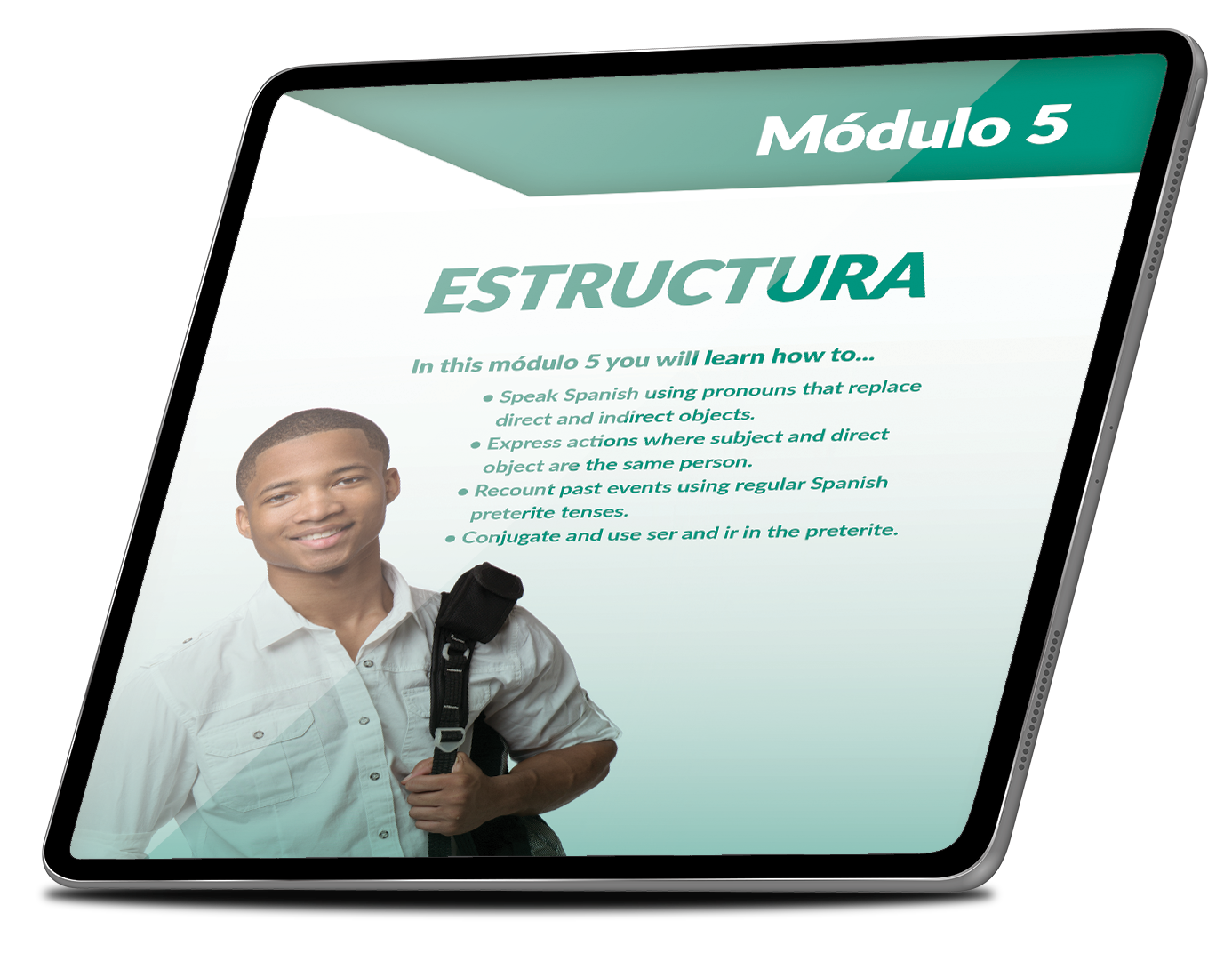
The Latin@s por siempre program supports a rich, visual and engaging approach to teaching and learning Spanish grammar.
The first activity of this section sets the stage for the learning objectives in each subsection. Students are asked to complete an introductory activity using visuals that require no previous knowledge of the topic, and help students focus on what will be learned.
The Observa que area is a general introduction to the grammatical topic presented, focusing on the use of the target structure as well as its form. Grammar points are illustrated with visually rich images and accompanying sentences that demonstrate those points. An English, non-literal translation is included to help students, especially those interested in Spanish/English translation.
Ten en cuenta offers a more detailed presentation that helps introduce nuances around the main structural topic. There are many examples of translations and practical communicative applications of the topics at hand.
Recapitulando is a space for formative assessment. Each Recapitulando section starts with a series of comprehension-checks, to ensure that students were able to follow the presentation. Terminology related to the topic is reviewed, and ample practice follows.
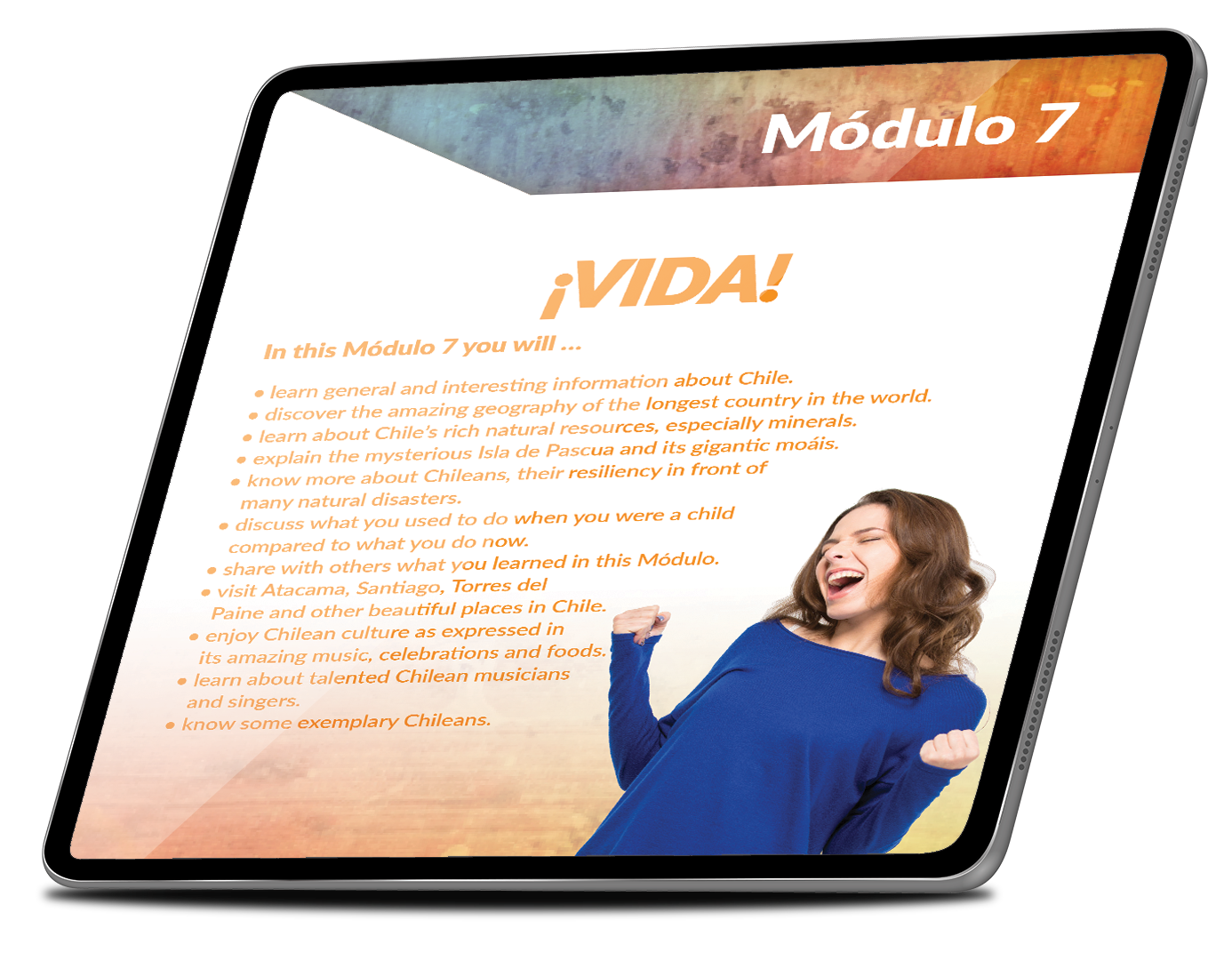
The Latinos por siempre ¡Vida! section is dedicated to each and every Spanish-speaking country, including the United States.
Naming this section ¡Vida! (vs. cultura) reflects our intention to introduce students to the many aspects of life in our countries.
Así es… is a visual introduction to the country in focus. Data related to population, political geography, flag, currency… among others. A simple True/False activity ensures critical thinking and comprehension.
Todo sobre… takes a glance at the history, geography, life and other relevant aspects of life in the target country, from past to present.
Hecho en… highlights the creation, the arts and crafts and others that are at the base of the ingenuity of the people of the target country.
Nuestra lengua is a visual reflection on how our language works and how it can be used in practical-communicative situations, following the premise that visual comprehension precedes oral production.
The Así somos… readings introduce students to the character and characteristics of the people of each target country.
The Para comunicarnos section focuses on functional uses of Spanish.
Si viajas a… is a virtual invitation to explore the most beautiful areas of the target countries. Si viajas a… represents an opportunity to familiarize students with the geography, the history, artistic manifestations, among others, of our beautiful Spanish-speaking countries.
Aprender enseñando is a section inviting students to share what they have acquired working with their preferred section of each módulo. The activity should be submitted via Discussions in Canvas or presented in class, after students have transformed their presentation in a short but meaningful vlog.
La rica cultura… highlights the different cultural values of the target country: Art, food, music…
…En nuestra música is an opportunity to learn and enjoy the musical highlights of target countries.
… ejemplares is dedicated to highlighting the contributions of some exemplary people, both men and women, from the target country, in areas such as the arts, sciences, humanitarian work…
Our Spanish for Heritage Speakers Courses

Módulo 1 is dedicated to Spanish as a global language. This module covers its initial development, evolution, history, and different adaptations throughout the world. Basic concepts such as the Spanish alphabet, cognates and numbers are introduced.
Palabras
| Todo sobre la historia de la lengua española | |
| Hecho en el mundo | |
| Para comunicarnos cortésmente | |
| Para mejorar nuestro español | |
| Mentalidad de crecimiento | |
| Así es el español en el mundo | |
| Diario de un estudiante: ¡No es mi culpa! | |
| Nuestros apellidos | |
| El idioma dominante | |
| El español en el mundo laboral: Las entrevistas de trabajo | |
| Los beneficios de la lectura | |
| El español en el mundo por escrito: Valeria Luiselli | |
| Si viajas a las maravillas del mundo hispanohablante | |
| La contribución de la cultura hispana al mundo | |
| El mundo hispanohablante en nuestra música | |
| Hispanos ejemplares |
| El alfabeto español y los caracteres especiales | |
| Los números en español | |
| Las sílabas | |
| Las categorías gramaticales en español | |
| Sustantivos. El género | |
| Sustantivos. El número | |
| Ortografía. La acentuación |
| Así es el español en el mundo | |
| Todo sobre la historia de la lengua española | |
| Hecho en el mundo | |
| Para comunicarnos cortésmente | |
| Nuestra lengua 1: Para mejorar nuestro español | |
| Nuestra lengua 2: Mentalidad de crecimiento | |
| Así es el español en el mundo | |
| Nuestro espejo. Diario de un estudiante: ¡No es mi culpa! | |
| Nuestro espejo: Nuestros apellidos | |
| Nuestro espejo: El idioma dominante | |
| Nuestro espejo. El español en el mundo laboral: Las entrevistas de trabajo | |
| El español en las redes sociales: Los beneficios de la lectura | |
| Si viajas a las maravillas del mundo hispanohablante | |
| El español en las redes sociales: Los beneficios de la lectura | |
| Aprender enseñando | |
| La contribución de la cultura hispana al mundo | |
| El mundo hispanohablante en nuestra música | |
| Hispanos ejemplares |

Módulo 2 is dedicated to nuestra gente from the United States, and looks at their heritage and essential contributions to the diversely rich United States.
Palabras
| Todo sobre los hispanos de los EE.UU. | |
| Hecho en los EE.UU. | |
| Para comunicarnos cuando estemos tristes | |
| Los orígenes hispanos de los EE.UU. | |
| Así son los hispanos de los EE.UU | |
| Estereotipos | |
| La comida y nuestra identidad | |
| Falsos cognados, I | |
| El español en el mundo laboral: Carreras en alimentación | |
| La puntuación amorosa | |
| El español por escrito: Cynthia Guardado | |
| Si viajas a los EE.UU | |
| La rica cultura hispana de los EE.UU. | |
| Los EE.UU. en nuestra música | |
| Hispanos ejemplares de los EE.UU. |
| Elementos del sistema verbal en español | |
| El presente de indicativo de los verbos regulares | |
| El presente de indicativo en verbos irregulares. Cambios en la raíz | |
| El presente de indicativo en verbos irregulares. Otras irregularidades | |
| Estar + gerundio | |
| Ortografía. Normas ortográficas de las letras, I | |
| Ortografía. El acento |
| Así son los Estados Unidos | |
| Todo sobre los hispanos de los EE.UU.Hecho en los EE.UU. | |
| Para comunicarnos cuando estemos tristes | |
| Nuestra lengua: Los orígenes hispanos de los EE.UU. | |
| Así son los hispanos de los EE.UU | |
| Nuestro espejo 1. Estereotipos | |
| Nuestro espejo 2. La comida y nuestra identidad | |
| Nuestro espejo 3. Falsos cognados, I | |
| Nuestro espejo 4. El español en el mundo laboral: Carreras en alimentación | |
| Nuestro espejo 5. El español en las redes sociales. La puntuación amorosa | |
| El español por escrito: Cynthia Guardado | |
| El español en las redes sociales: Los beneficios de la lectura. | |
| Si viajas a los EE.UU. | |
| Aprender enseñando | |
| La rica cultura hispana de los EE.UU. | |
| Los EE.UU. en nuestra música | |
| Hispanos ejemplares de los EE.UU. |

Módulo 3 is dedicated to the amazing country of Puerto Rico and its people. Students are introduced to many activities that can be performed and to words that are used in Spanish to label vocations.
Palabras
| Todo sobre Puerto Rico | |
| Hecho en Puerto Rico | |
| Para compartir nuestras historias | |
| La evolución del español y sus peculiaridades fonéticas dialectales | |
| Así son los puertorriqueños | |
| ¿Cómo nos percibimos? | |
| ¿Cómo te llamas? El origen de nuestros nombres | |
| Falsos cognados, II | |
| El español en el mundo laboral: Carreras en interpretación, I | |
| La importancia de comunicarse correctamente | |
| Puerto Rico por escrito: Marisel Hilerio | |
| Si viajas a Puerto Rico | |
| La rica cultura puertorriqueña | |
| Puerto Rico en nuestra música | |
| Puertorriqueños ejemplares |
| El pretérito perfecto simple | |
| El pretérito imperfecto | |
| El pretérito perfecto simple vs. el pretérito imperfecto | |
| Verbos de valoración | |
| Ortografía. Normas ortográficas de las letras, II |
| Así es Puerto Rico | |
| Todo sobre Puerto Rico | |
| Hecho en Puerto Rico | |
| Para compartir nuestras historias | |
| Nuestra lengua: La evolución del español y sus peculiaridades fonéticas dialectales | |
| Así son los puertorriqueños | |
| Nuestro espejo 1. ¿Cómo nos percibimos? | |
| Nuestro espejo 2. ¿Cómo te llamas? El origen de nuestros nombres | |
| Nuestro espejo 3. Falsos cognados, II | |
| Nuestro espejo 4. El español en el mundo laboral: Carreras en interpretación, I | |
| Nuestro espejo 5. El español en las redes sociales: La importancia de comunicarse correctamente | |
| Puerto Rico por escrito: Marisel Hilerio | |
| Si viajas a Puerto Rico | |
| Aprender enseñando | |
| La rica cultura puertorriqueña | |
| Puerto Rico en nuestra música | |
| Puertorriqueños ejemplares |

Módulo 4 highlights beautiful and diverse España. This module places emphasis on its amazing and varied geography. Later, students learn about Spanish food and the steps to prepare it.
Palabras
| Todo sobre España | |
| Hecho en España | |
| Para hablar de nuestra rutina diaria | |
| Expresiones, dichos y refranes | |
| Así son los españoles | |
| Estudiar como hablante de herencia | |
| Nuestros pueblos | |
| Falsos cognados, III | |
| El español en el mundo laboral: Carreras en interpretación, II | |
| El uso de la coma | |
| España por escrito: Almudena Grandes | |
| Si viajas a España | |
| La rica cultura española | |
| España en nuestra música | |
| Españoles ejemplares |
| El futuro simple | |
| Los verbos reflexivos y pronominales | |
| Las expresiones indefinidas y negativas | |
| El pronombre lo y sus usos | |
| Los pronombres como complemento directo o indirecto | |
| Ortografía. Palabras homófonas |
| Así es España | |
| Todo sobre España | |
| Hecho en España | |
| Para comunicarnos: para hablar de nuestra rutina diaria | |
| Nuestra lengua: Expresiones, dichos y refranes | |
| Así son los españoles | |
| Nuestro espejo 1. Estudiar como hablante de herencia | |
| Nuestro espejo 2. Nuestros pueblos | |
| Nuestro espejo 3. Falsos cognados, III | |
| Nuestro espejo 4. El español en el mundo laboral: Carreras en interpretación, II | |
| Nuestro espejo 5. El español en las redes sociales: El uso de la coma | |
| España por escrito: Almudena Grandes | |
| Si viajas a España | |
| Aprender enseñando | |
| La rica cultura española | |
| España en nuestra música | |
| Españoles ejemplares |

Módulo 5 is dedicated to nuestra gente from the Mexico, and looks at their heritage and essential contributions to the diversely rich Mexican.
Palabras
| Todo sobre México | |
| Hecho en México | |
| Para hacer un uso efectivo de las redes sociales. | |
| El español como lengua binaria, I | |
| Así son los mexicanos | |
| Malintzin: La mujer | |
| Nuestras lacras: Los feminicidios y la violencia machista | |
| Calcos, anglicismos y cambio de código | |
| El español en el mundo laboral: La educación bilingüe | |
| El valor del aprendizaje y del estudio | |
| México por escrito: Brenda Navarro | |
| Si viajas a México | |
| La rica cultura mexicana | |
| México en nuestra música | |
| Mexicanos ejemplares |
| El imperativo | |
| Deber + infinitivo | |
| Tener que + infinitivo | |
| El infinitivo. Sus usos sustantivados. | |
| El gerundio. Sus usos adverbiales. | |
| Perífrasis verbales | |
| Ortografía. Abreviaturas |
| Así es México | |
| Todo sobre México | |
| Hecho en México | |
| Para hacer un uso efectivo de las redes sociales. | |
| Nuestra lengua: El español como lengua binaria, I | |
| Así son los mexicanos | |
| Nuestro espejo 1. Malintzin: La mujer | |
| Nuestro espejo 2. Nuestras lacras: Los feminicidios y la violencia machista | |
| Nuestro espejo 3. Calcos, anglicismos y cambio de código | |
| Nuestro espejo 4. El español en el mundo laboral: La educación bilingüe | |
| Nuestro espejo 5. El español en las redes sociales. El valor del aprendizaje y del estudio | |
| México por escrito: Brenda Navarro | |
| Si viajas a México | |
| Aprender enseñando | |
| La rica cultura mexicana | |
| México en nuestra música | |
| Mexicanos ejemplares |

Módulo 6 is dedicated to nuestra gente from the Costa Rica, and looks at their heritage and essential contributions to the diversely rich Costa Rica.
Palabras
| Todo sobre Costa Rica | |
| Hecho en Costa Rica | |
| Para lidiar con situaciones imprevistas | |
| El español como lengua binaria, II | |
| Así son los costarricenses | |
| ¡Pura Vida! | |
| La toponimia en español | |
| Cambio de código | |
| El español en el mundo laboral: Las nuevas tecnologías | |
| Ortografía | |
| Costa Rica por escrito: Anacristina Rossi | |
| Si viajas a Costa Rica | |
| La rica cultura costarricense | |
| Costa Rica en nuestra música | |
| Costarricenses ejemplares |
| La oración compuesta | |
| El condicional simple | |
| El condicional perfecto | |
| Oraciones condicionales con condiciones reales | |
| La preposición, I | |
| Ortografía. La fórmula mágica de la acentuación |
| Así es Costa Rica | |
| Todo sobre Costa Rica | |
| Hecho en Costa Rica | |
| Para lidiar con situaciones imprevistas | |
| Nuestra lengua: El español como lengua binaria, II | |
| Así son los costarricenses | |
| Nuestro espejo 1. ¡Pura Vida! | |
| Nuestro espejo 2. La toponimia en español | |
| Nuestro espejo 3. Cambio de código | |
| Nuestro espejo 4. El español en el mundo laboral: Las nuevas tecnologías | |
| El español en las redes sociales | |
| Nuestro espejo 5. Ortografía | |
| Costa Rica por escrito: Anacristina Rossi. | |
| Si viajas a Costa Rica | |
| Aprender enseñando | |
| La rica cultura costarricense | |
| Costa Rica en nuestra música | |
| Costarricenses ejemplares |

Módulo 7 is dedicated to the amazing country of Chile and its people. Students are introduced to many activities that can be performed and to words that are used in Spanish to label vocations.
Palabras
| Todo sobre Chile | |
| Hecho en Chile | |
| Consejos para vivir bien | |
| Variaciones del español | |
| Así son los chilenos | |
| Del caudillismo a los populismos | |
| Lo que nos divierte | |
| Falsos cognados IV | |
| El español en el mundo laboral: Las artes | |
| El arte | |
| Chile por escrito: Isabel Allende | |
| Si viajas a Chile | |
| La rica cultura chilena | |
| Chile en nuestra música | |
| Chilenos ejemplares |
| El presente de subjuntivo | |
| El subjuntivo con valor condicional | |
| Expresiones de cortesía | |
| Prefijos, sufijos e interfijos | |
| Ortografía. Cláusulas adjetivas de indicativo vs. de subjuntivo |
| Así es Chile | |
| Todo sobre Chile | |
| Hecho en Chile | |
| Para comunicarnos: Consejos para vivir bien | |
| Nuestra lengua: Variaciones del español | |
| Así son los chilenos | |
| Nuestro espejo 1. Del caudillismo a los populismos | |
| Nuestro espejo 2. Lo que nos divierte | |
| Nuestro espejo 3. Falsos cognados IV | |
| Nuestro espejo 4. El español en el mundo laboral: Las artes | |
| Nuestro espejo 5. El español en las redes sociales. El arte | |
| Chile por escrito: Isabel Allende | |
| Si viajas a Chile | |
| Aprender enseñando | |
| La rica cultura chilena | |
| Chile en nuestra música | |
| Chilenos ejemplares |

Módulo 8 highlights beautiful and diverse Bolivia. This module places emphasis on its amazing and varied geography. Later, students learn about Spanish food and the steps to prepare it.
Palabras
| Todo sobre Bolivia | |
| Hecho en Bolivia | |
| Para hablar de lo que ha ocurrido | |
| El registro y el lenguaje coloquial | |
| Así son los bolivianos | |
| ¿Una herencia feudal? | |
| Todos emigramos | |
| Biografías y autobiografías | |
| El español en el mundo laboral: Interpretación médica | |
| Cognados y palabras homófonas | |
| Bolivia por escrito: Giovanna Rivero | |
| Si viajas a Bolivia | |
| La rica cultura boliviana | |
| Boliviaen nuestra música | |
| Bolivianos ejemplares |
| El pretérito perfecto compuesto | |
| El verbo haber (hay y verbo auxiliar) | |
| Adverbios | |
| Grados de los adjetivos | |
| Ortografía. Usos de muy y mucho |
| Así es Bolivia | |
| Todo sobre Bolivia | |
| Hecho en Bolivia | |
| Para comunicarnos: Para hablar de lo que ha ocurrido | |
| Nuestra lengua: El registro y el lenguaje coloquial | |
| Así son los bolivianos | |
| Nuestro espejo 1. ¿Una herencia feudal? | |
| Nuestro espejo 2. Todos emigramos | |
| Nuestro espejo 3. Biografías y autobiografías | |
| Nuestro espejo 4. El español en el mundo laboral: Interpretación médica | |
| Nuestro espejo 5. El español en las redes sociales: Cognados y palabras homófonas | |
| Bolivia por escrito: Giovanna Rivero | |
| Si viajas a Bolivia | |
| Aprender enseñando | |
| La rica cultura boliviana | |
| Bolivia en nuestra música | |
| Bolivianos ejemplares |
